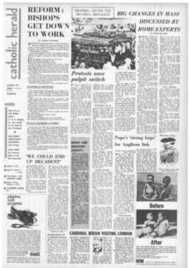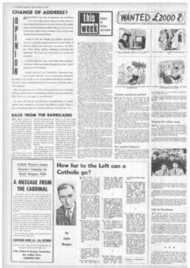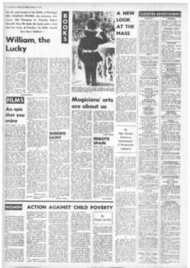Page 5, 14th October 1966
Page 5

Report an error
Noticed an error on this page?If you've noticed an error in this article please click here to report it.
Tags
Share
Related articles
Seminaries For Secret Agents
Pope Invitation To Bishop Tried To Forge Pope Link With...
Pius' Silence Hid Perils
Pope Pius And Nazis' Victims
The Jews And Pius Xii By Two Writers Who Met Him
FR. ROBERT A. GRAHAM, S.J., looks at Saul Friedlander's controversial
book `Pius XII and the Third Reich' published by Chatto and Windus at 35s. Fr. Graham and Mr. Friedlander both worked for doctorates at the Graduate Institute of International Studies at the University of Geneva. Both have also worked in the archives of the German Foreign Office. Fr. Graham, who has written an authoritative study 'Vatican Diplomacy', finds that Mr. Friedlander has conceived
A Safe and Convenient Way of Writing History
PIUS XII
and the
Third Reich
A Documentation by SAUL FIRIEDLANDER
AMONG the Reich Foreign Ministry documents preserved from Nazi desruction through the courage of the archivist, the recently deceased Dr. Johannes Ulrich, were five fat volumes covering the war years labelled "Vatican Relations".
Into them were bound the reports of the National Socialist ambassadors at the Vatican, the memos of communications from the Papal Nuncio in Berlin, internal memos of the State Secretary and occasional intelligence information from the Gestapo, The Friedlander book results from use of the Ullrich papers. The documents consulted and cited arc neither new nor secret. They were used at the International Military Tribunal at Nurenberg and also at the American-conducted Foreign Ministry (Wilhelmstrasse) trials.
From these documents the prosecution derived evidence not of Vatican softness, let alone sympathy towards the Nazi regime, but the proof of
religious persecution and crimes against humanity cornmitted against Church representatives.
From this evidence, the State Secretary. Ernst von Weizsacker (from 1943, Ambassador to the Holy See) was sentenced to a prison term as a war criminal. This same Weizsacker figures here as the author's "hero" and major witness.
THE reader may be baffled by the methodology, which introduces an entirely new genre of historical criticism. The general thesis (to the extent that the author will admit of one) is that Pope Pius XII was so obsessed with the fear of Communism that he considered the Nazis as an indispensable bulwark against the Bolsheviks.
The Pope is conceived to have refrained from criticising or condemning the Hitler regime out of concern lest in so doing he might "weaken the Reich". In the end, after leading the reader to believe that some point is being definitively established, the author retreats into disavowals. He claims that the documents speak for themselves.
He wanted, he writes, "to adhere as much as possible to the documents," joining only "occasional added comments". He says that "occasionally I take a position." In reality, hardly a document is without the benefit of wide-ranging hypotheses. followed by prudent disclaimers.
The book is replete with such phrases as : "We cannot make any definite answer" or "the hypothesis cannot be en tirely excluded . ." or "no documentary evidence exists, but ..." or "of course this report has to be read with caution."
Through this device the writer spares himself the hard work of anchoring his surmises to the facts while at the same times launching very hardy theories, such as the notion that the Pope did not openly condemn the slaughter of the Jews (and Poles) because this would tend to undermine Nazi military and political power so necessary to preserve Europe from the Red scourge.
This is a very safe and convenient way of writing history.
AS for the documents themselves, they are very disparate in character and of uneven reliability, ranging from formal communications to information passed on by tipsters.
Some are manifestly sheer invention, such as the interview alleged to have taken place between Pope Pius XII and the U.S. chargé d'affaires, Harold Tittman, which the ambassador seriously passed on to his superiors and which the author deemed fit to include in his selection (with the usual discreet disavowal).
Tittman, now living in Washington, has declared that there is not a word of truth in the story. But his denial was not really necessary for a serious critic to stigmatise its fraudulency.
Other reports are simply false, sent out for Axis propaganda purposes, such as von Bergen's claim in June, 1940. that the Vatican felt that France and Belgium should immediately sign a peace treaty and acquiesce in the German victory. Hardly any of the documents, of whatever origin, are straightforward. All need more knowledgeable scrutiny than the author is apparently able or willing to give. The author is convinced that van Bergen and his successor von Weizsticker were reliable reporters and would not send dispatches just to please Berlin. One wonders how carefully Prof. Friedlander read the Ulrich archives.
For Bergen himself admits he had an Italian journalist in his pay, through whom he' could present the German viewpoint to the Italian Catholic press, naturally presenting Vatican attitudes in a sense most helpful to the Axis cause. These reports, originating in the Embassy later figure in Bergen's dispatches as "Vatican opinion."
BERGEN was ailing and defeated, and he can be forgiven for taking the line of least resistance. But Weizsacker was younger and had a strategy of his own. It was his idea to try to convince. Berlin that they could sue for peace through the Vatican, using the anti-Communist theme.
This was completely in accord with the vast Goebbelsorganised propaganda campaign based on fear of the "spectre of communism" in Europe.
He also thought he could arouse Vatican support on the same basis. Ile failed at both ends. Berlin was not interested in peace, let alone one helped along by the Vatican. And Pius XII failed to react to the anti-Communist theme.
There are .a half-dozen documents produced here stressing the theme of the alleged Vatican "nightmare" over Communism. Not one of them quotes the Pope or any of his qualified representatives. What the Vatican had to say about the post-war Communist danger it said candidly not to the Nazis but to the Americans and the British.
Some of Weizsacker's efforts to build up the picture of a Vatican desperately praying the Wehrmacht would hold out are truly pathetic. The German Ambassador saw the Pope and Cardinal Maglione (or Mgr.
Tardini or Montini) often.
NoWhere in these dispatches is there any mention by him of any such sentiments on the part of these persons. Had the Pope • hinted anything to this effect one can be sure Weizsacker would not have delayed in getting word to Berlin.
In fact, however, the closest he comes to mentioning any such attitude is on the occasion of presenting his credentials at which time he could only report observing a change of breathing when Weizsacker mentioned Communism!
Weizsacker's failure to make progress and his failure to report any direct Vatican reaction is a valid measure, I should think. just how close the Pope was to regarding the Nazis as a bulwark for the Church and Europe against the Reds.
PROF. Friedlander's use of references from the Vatican side set a sort of record. At least three times he errs egregiously in connection with the Osservatore Romano. He devotes 18 lines of moralistic speculation on an editorial that never appeared in this newspaper.
He solemnly records that When the Holy Office condemned euthanasia in 1940. neither the Osservatore Romano nor Vatican Radio men tioned it. The reader is left to suspect something sinister in this omission.
In the same tone of hushed concern, he speaks of the "secret" papal allocution of June 2, 1943. Had he taken the usual elementary precautions to check, he would have found both the euthanasia of decree and the "secret" address on the front pages of the Osservatore Romano at the proper date.
Small details? Not when these "minor" errors are repeated and compounded by others without contradiction. Even so balanced a writer as Walter Laqueur, reviewing the American edition in the New York Times Book Magazine, cited two of these three falsities in all good faith as significant signposts of Vatican policy. This is legend-making, not history.
ONE must conclude from reading this book that the author has a very low regard for the intelligence of the Holy See and of Pius XII. For years the Nazi regime had been giving repeated proof of its intention to destroy the Church.
Already in that part of Poland annexed to Germany a pilot project under Greiser was under foot, later to be extended to the rest of the country ; for years the Vatican's efforts to come to the relief of the Poles had run up against Nazi refusals until in 1942 Berlin brutally declared it would not even receive any notes dealing with that afflicted country.
On March 2, 1943, just before Weizsacker came to Rome, he had the duty as State Secretary to receive a stiff note of protest from Cardinal Maglione which, by Vatican standards. was nearly an ultimatum. As the war approached its climax, there were no signs of any softening of hearts in Berlin, quite the contrary.
And despite all this, like a not too smart wife with a husband Who beats her, Pius XII is described as looking upon Nazi Germany as the bulwark of Christian Europe against the Red hordes. Pius XII, whatever one may think of his policies, deserves more credit than that.
blog comments powered by Disqus









